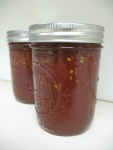 Tomatoes may be a summertime staple, but you can turn them into an autumn (or anytime) treat by making Spiced Tomato Jam. In this recipe, traditional tomato flavor is warmed by the addition of allspice, cinnamon, and cloves, sweetened by sugar, and brightened up by lemon rind and juice. The lemon juice also helps make sure the acidity is where it needs to be to get a good gel. In addition to the ingredients mentioned, you’ll also need a box of powdered pectin.
Tomatoes may be a summertime staple, but you can turn them into an autumn (or anytime) treat by making Spiced Tomato Jam. In this recipe, traditional tomato flavor is warmed by the addition of allspice, cinnamon, and cloves, sweetened by sugar, and brightened up by lemon rind and juice. The lemon juice also helps make sure the acidity is where it needs to be to get a good gel. In addition to the ingredients mentioned, you’ll also need a box of powdered pectin.
Peeling tomatoes may seem like an unimportant extra step, but the texture of the skin was determined to be undesirable and product testing did not include considerations of how the skin would alter the final product safety. So, scald, peel, and chop tomatoes as described in the procedure. Our canning recommendations are meant to be followed as written, since that is how they were developed and changing ingredients or steps may influence not only the quality but also the safety of the final product.
Complete recipe, procedure and boiling water canning process times are on the NCHFP website: Spiced Tomato Jam.
People also sometimes ask if they can use commercially canned tomatoes in our tomato recipes, but quantity, consistency, and even acidity could be different in commercially canned tomatoes as compared to fresh tomatoes, so we do not recommend using them when fresh tomatoes are called for in a canning recipe.
Wondering what to do with tomato jam? Try serving it on a crackers and cheese platters, smothered over baked brie, or as a condiment with meat dishes. It’s also nice to taste simply spread on toast!







You must be logged in to post a comment.